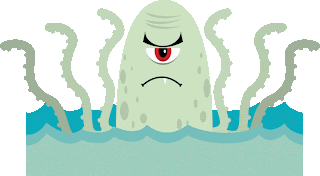Comparing Hippocampus with Kraken is a study in opposites. For example, Hippocampus has recognizable body parts such as the upper body of a
horse, the lower boy of a fish, and the fluked tail of a dolphin. Kraken is more of an amorphous blob
with multiple arms. Rising from the depths of the ocean, fierce Kraken would grab ships with its arms,
drag them down, and eat the people inside. In contrast, friendly Hippocampus would tow disabled ships to
shore and aid drowning sailors. Found throughout the seas of the world, Hippocampus is often seen near the
shore in the white foam of the waves. Meanwhile, Kraken prefers the deeper oceans. This beast often signals its
presence by creating a giant whirlpool.
However, Kraken and Hippocampus do have one thing in common – Poseidon, the Greek God
of the Sea. To pull his golden chariot, Poseidon created Hippocampus from sea foam. Called by a Norse name, Kraken is better known to the Greeks as
Scylla and Charybdis. Poseidon’s wife, Amphitrite, jealous of his infatuation
with Scylla, changed her into a Kraken.
Meanwhile, Charybdis, Poseidon’s daughter, was punished by Zeus for stealing
cows. Unlike Scylla, sailors know only of Charybdis by her gigantic whirlpool. Scylla and Charybdis now live in the Strait of Messina, between Italy and
Sicily.
Works Used:
Allan, Tony, “The Mythic Bestiary,” Duncan Baird: London, 2008.
Krystek, Lee, “The Kraken,” The UnMuseum, 2006, http://www.unmuseum.org/kraken.htm.
Nigg, Joseph, “The Book of Dragons and Other Mythical Beasts,” Quarto: London, 2002.
Zell-Ravenheart,
Oberon and Ash DeKirk, “A Wizard’s
Bestiary,” New Page Press: Franklin Lakes, NJ, 2007.


No comments:
Post a Comment